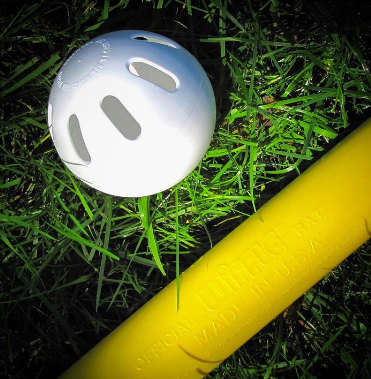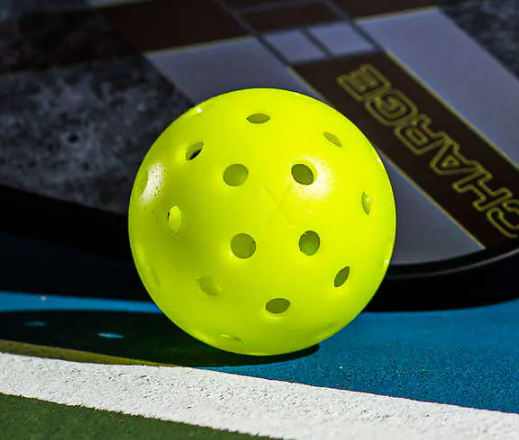Last Updated on August 11, 2023 by Drew Pierce
Why Getting Hit by a Pickleball Hurts More Than a Wiffle Ball
I can still feel the sting.
As I stood on the pickleball court, trying to shake off the shock from a pickleball that had just made a rather painful introduction with my neck, my opponent chuckled and remarked, “Come on, it’s only a wiffle ball!”
That casual dismissal irked me more than the actual hit.
Prefer to listen to this post? Click below:
While wiffle balls and pickleballs might appear like siblings at first glance, they are worlds apart in weight and impact, making them more like distant cousins.
And when you factor in that a pickleball can reach 40mph and be sent in your direction from as close as 7 feet away, don’t tell me getting hit doesn’t hurt. Sadly, pickleball injuries are on the rise, many because players are being struck by the ball.
But I did get my revenge: I spent the rest of the match polishing this dude’s obnoxious Selkirk sneakers.
Let’s look at the differences between wiffle balls and pickleballs and debunk and dive into why getting hit by a pickleball is no laughing matter.

What Are Wiffle Balls Made Of?
The wiffle ball is a marvel of simplistic design that has brought joy to countless backyard athletes. Here’s an overview of its construction:
Material:
The wiffle ball is made out of lightweight, durable plastic. This ensures it’s light enough to be safe for casual play but sturdy enough to withstand hits, tosses, and the occasional over-enthusiastic dog chase.
Design:
The most distinguishable feature of a wiffle ball is its series of perforations, usually eight oblong holes, placed on one half of the ball. The other half is solid. This design is crucial because it allows the ball to curve easily when thrown with a bit of spin, making the game more dynamic and interesting. It also means the ball won’t travel as far or as fast as a regular baseball, reducing the chance of injury or damage.
Size:
Wiffle balls are typically about the same size as a regulation baseball, which is approximately 2.86 inches (72.64 mm) in diameter. However, there are various sizes available on the market, tailored to different age groups and play styles.
Origin of Design:
The wiffle ball’s unique design was not a random choice. David N. Mullany, the inventor of the wiffle ball, observed kids in his neighborhood trying to play baseball with a perforated plastic golf ball and a broomstick. The aim was to curve the ball, but with limited success. Mullany then experimented with different designs and hole configurations, finally landing on the wiffle ball’s signature look. The asymmetric design ensured that the ball would curve unpredictably, adding a fun challenge to the game.
Production:
Wiffle balls are manufactured through a process of plastic injection molding. Melted plastic is injected into a mold in the shape of half a wiffle ball. Two of these halves are then joined together to form a complete ball. After cooling and solidifying, the ball is removed from the mold, and voilà! Ready for play.
The wiffle ball is a perfect example of how a simple design change—like adding a few holes—can completely transform the dynamics of a game. It’s no wonder it has remained a favorite for recreational play for decades. Whether you’re looking to play a curveball without investing in years of pitching practice or simply want a safer alternative to baseball in your backyard, the wiffle ball is your go-to choice!
Next up, the pickleball, a central component of a sport that’s been gaining considerable popularity:

What Is a Pickleball Made Of?
Pickleballs are made from a durable polymer material. The choice of polymer ensures the ball is sturdy enough for competitive play but also lightweight to allow for the fast-paced nature of the game. Learn about the differences between indoor and outdoor pickleballs.
Design:
The most distinctive feature of a pickleball is its pattern of holes. Unlike the wiffle ball’s asymmetrical design, pickleballs have holes evenly distributed around their surface. These holes can be round or oval, and their uniform distribution aids in the ball’s aerodynamics, allowing for straighter trajectories and reducing the impact of wind during outdoor play.
Size:
A standard pickleball is slightly smaller than a wiffle ball, with a diameter ranging from 2.874 to 2.972 inches (73.025 to 75.438 mm). This size makes it manageable for the quick volleys and dinks characteristic of the sport.
Origin of Design:
The design of the pickleball was developed in sync with the creation of the game itself, which originated in the mid-1960s. The game was a blend of badminton, tennis, and table tennis, and thus, the ball was designed to cater to the unique playing conditions of pickleball—a smaller court and specific paddle requirements. The hole pattern was optimized for playability, ensuring a balance between speed and control.
Production:
Manufacturing a pickleball also typically involves injection molding. The polymer material is melted down and injected into a mold that shapes half of the pickleball. Two such halves are produced and then fused together to make the complete ball. Once cooled and solidified, the ball is extracted from the mold, inspected for quality, and is then ready for a game.
The pickleball’s construction is a testament to the innovation of game equipment tailored to specific sports. It has been designed to meet the unique demands of pickleball, ensuring optimal performance on the court. If you’re looking for rapid rallies, clever drop shots, and a game that provides both aerobic and strategic challenges, then pickleball—with its specially designed ball—is waiting for you!
Getting hit my a ball of any shape or size is not fun. So when playing the great sport of pickleball, remember: no headhunting! And if someone gets struck with a ball during a match, show some compassion and check in to ensure they are OK. Because a pickleball is most definitely not a wiffle ball.



Great guide! excellent comparison